Rising thousands of feet above the desert floor and supporting a strangely lush desert forest, the Chisos are a highly sought after hiking destination for Big Bend bound travelers. Standing at the tallest summit in the park is an experience that can't be missed in West Texas.
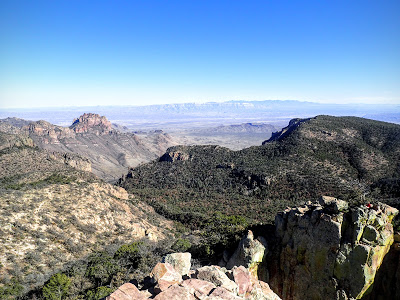 |
| Sky Island |
The appropriately named "Sky Islands" of the American Southwest are a naturalist's gem and a hiker's delight. When otherwise arid and comparatively flat desert landscapes are interrupted by rugged mountain ranges, life adapts appropriately. When I visited Big Bend National Park in January, a recent winter storm had dumped a full 6 inches of snow at the higher summits of the Chisos Mountains. Plants often associated with arid grandeur were blanketed in powder and ice which is not an entirely uncommon site in these mountains. The sparsely vegetated desert life blooms more abundantly the higher one goes in the Chisos.
Hiking Emory Peak is the shortest hike which the rare environment can be appreciated, however it really is just the tip of the iceberg. Starting at the Chisos Basin Lodge, the hike quickly ascends into the alpine forests.
This is a popular hike so I didn't have the solitude I enjoyed canoeing the Rio Grande or on the less traversed hikes of the park. Nevertheless, the views were still abundant even in the thick growth of the higher elevations. "The Window", was a magnificent site as the trail climbed higher. Aptly named "the pinnacle trail", limestone towers rise prominently along the trail. Though not particularly suited for rock climbing, they are another gorgeous site along the trail.
The hike itself is consistently steep but with switchbacks and a well trod trail which prevents it from being too strenuous. Air is noticeably thinner but that just made it more appealing to stop and take in the scenery. Despite the steepness, I didn't find any part of the hike to be miserable.
I was a bit bummed that I didn't chose to do this as a backpacking trip. Numerous sites existed along the way and I would be missing the famous "South Rim" where campers perch above a 1,000 foot cliff that faces the Rio Grande and the mountain ranges of Mexico. I would have to return to see that other great section of the park.
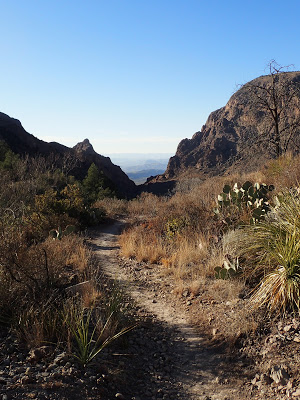 |
| Looking towards "The Window" |
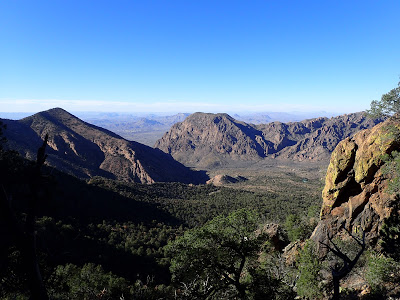 |
| The lush forests of the Chisos Basin |
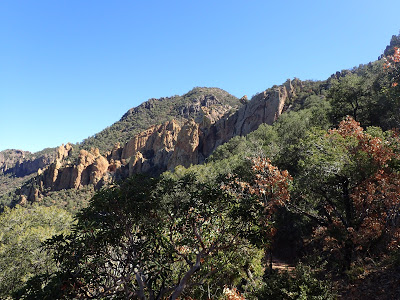 |
| Limestone pinnacles along the way |
The final mile along the spine of the Chisos to Emory Peak has South facing views where the views of "El Despoblado" (the uninhabited) are best. The striated summits of Mexico's Sierra Del Carmen hold some of the most remote landscapes on the continent. A thin green line shows the clear evidence of the Rio Grande and even the notch of Boquillas Canyon is faintly visible. There are a few residents along the Mexico side of the border but none of this is evident from the summit; it looked as inhabited as the Moon from up here.
I should note that the last 50-100 feet up to the summit are a pure scramble with some fairly significant exposure. It is not for the faint at heart. There are actually two summits of almost equal altitude and I would recommend scrambling up both as one holds prominent views to the North and the other has the panoramic view of the Rio Grande Valley. With the ambient temperature holding at just about 70 degrees, a light breeze and not a cloud in sight, it was a rare example of a summit that was pleasant enough to spend a few hours.
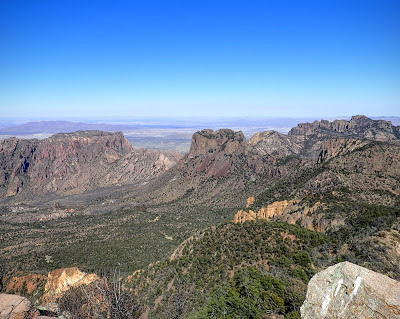 |
| The basin, viewed from the summit |
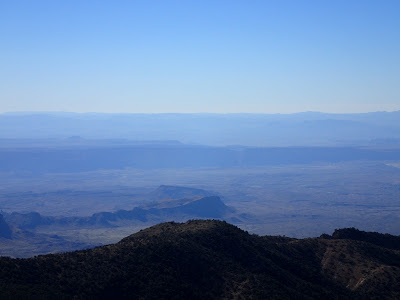 |
| Looking towards the Rio Grande |
At 10.5 miles in length, it was a most-of-the day affair but it really wasn't as strenuous as most of the guidebooks made it out to be. I was not hiking at a fast pace and managed to finish the hike in about 8 hours with probably 2-2.5 hours worth of stopping time.
While Mt Emory is probably climbed by the majority of hikers who visit Big Bend National Park, it status as a West Texas classic is well-deserved. If I could hike it again, I would have made it a backpacking trip with an overnight at the South Rim. Something to come back to, I suppose!












No Comments